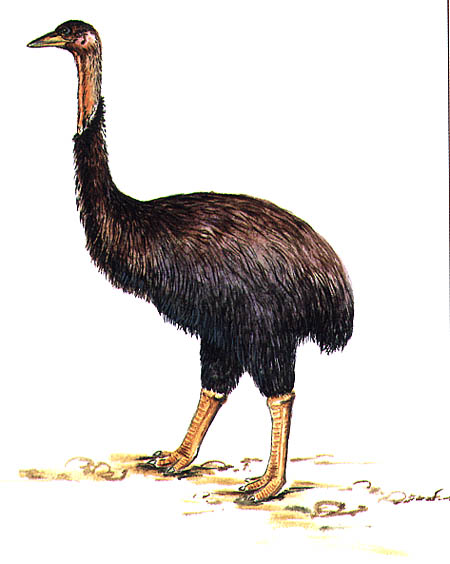This entry will give a small introduction into why many scientists feel that we have entered the 'Sixth Mass Extinction'.
Within the last 2,000 years a large number of species have become extinct in ways clearly linked to human dispersal or activity. Here are some examples:
- In the 1500s several species became extinct in New Zealand after Polynesian settlers arrived. This included ten species of Moa (giant flightless ratite birds).
- Over 2,000 Pacific bird species have become extinct since the arrival of humans over the last 500 years (Steadman 1995).
- The arrival of humans 2000 years ago in Madagascar led to the majority of the islands megafauna becoming extinct. This includes the Aepyomism or 'Elephant Bird' (a giant flightless bird), 17 of 50 species of lemur and a giant tortoise.
- Around 500 years ago a number of species became extinct upon human settlement on islands in the Indian Ocean. This included several species of giant tortoise on the Seychelles and Mascarene islands.
- Other notable examples of modern extinctions include the Tasmanian Tiger, the Quagga, the Dodo, and the passenger pigeon of North America which became extinct as late as 1914.
(Picture showing the large size of a Moa compared to an Ostrich. From http://www.copyrightexpired.com/earlyimage/bones/large/large_extinctanimals_moa.jpg )
(Drawing of the Aepyomism which stood at over 3m tall and weighed approximately 450kg. From http://hoopermuseum.earthsci.carleton.ca/flightless/aepyorn.jpg )
The report states that after the emergence of modern humans few known extinctions occur in the areas of longest occupancy (Africa and Eurasia), and those that do occur are spread out. However, the migration of human beings into other areas is linked to the loss of a large number of large vertebrate species, as shown in the below map.
(Map showing human migration patterns, and extinction events over the last 100,000 years. From http://www.amnh.org/science/biodiversity/extinction/IntroFourteenFS.html)
The most shocking loss of species was in North and South America where some 135 mammal species were lost, representing 70% of North Americas large mammals when humans migrated from Asia between 12,500 and 10,000 years ago. Other examples where human settlement has coincided with extinction episodes include Hawaii (1,600 to 1,400 years ago), the West Indies (7,000 years ago), and the Mediterranean Islands (10,000 years ago). Notably all terrestrial vertebrates outside of Africa and Asia that weighed more than 1,000 kg have become extinct.
Human activities that are believed to impact extinctions include: overhunting, introduction of infectious diseases, increased interspecific competition, habitat destruction, and the introduction of exotic species.
It is this evidence that has led many scientists to believe that we have entered a period of accelerated anthropogenic mass extinction. Here are a couple of quotes to enjoy:
- Niles Eldredge (1999): "It is well established that the Earth is undergoing yet another mass extinction event, and is clear that the major agent for this current event is homo sapiens".
- Edward Wilson (2002): "At current rates of human destruction of the biosphere, half of all species will be extinct in 100 years".
- Richard Leakey (1996): "It's the next annihilation of vast numbers of species. It is happening now and we, the human race, are its cause".
References:
Centre for Biodiversity and Conservation Conference. Humans and other catastrophes: perspectives on extinction. New York. American Museum of Natural History. Available at: http://www.amnh.org/science/biodiversity/extinction/IntroSymposiumFS.html
Eldredge, N. (1999). Cretaceous meteor showers, the human ecological niche and the sixth extinction. Centre for Biodiversity and Conservation Conference. Humans and other catastrophes: perspectives on extinction. New
York. American Museum of Natural History.
http://hoopermuseum.earthsci.carleton.ca/flightless/aepyorn.jpg
http://www.copyrightexpired.com/earlyimage/bones/large/large_extinctanimals_moa.jpg
Leakey, R. (1996) The Sixth Extinction. Weidenfield and Nicolson: London.
Steadman, D. W. (1995). Prehistoric extinctiond of Pacific island birds: biodiversity meets zoo archaeology. Science. 267: 1123-1131.
Wilson, E. O. (2002). The future of life. Vintage.



No comments:
Post a Comment